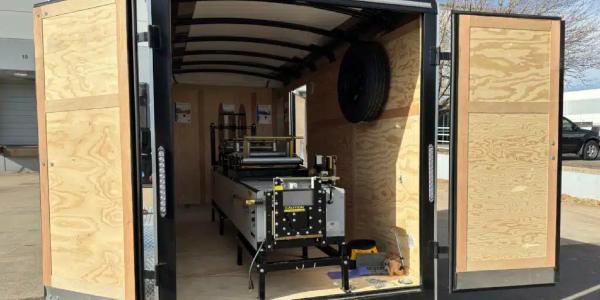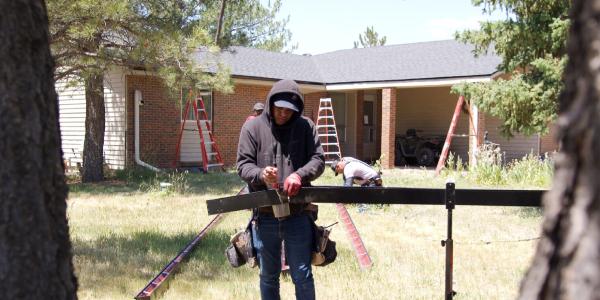UP TO THE MINUTE
The case for seamless gutters

By New Tech Machinery.
When it comes to choosing gutters for your next project, seamless gutters offer far superior results compared to prefabricated solutions.
While the convenience of purchasing prefabricated, mass-produced gutters from the hardware store might be tempting, there are many downsides and risks. Sectional gutters are prone to clogging, or worse, leaking, making them a nuisance to maintain and offer only a short lifespan. On the other hand, seamless gutters produced with a portable rollforming machine offer far superior results, aesthetics and lasting lifespan.
New Tech Machinery (NTM) manufactured its first portable seamless gutter machine 30 years ago and has been going strong ever since with its Mach II series. With decades of experience helping gutter installers build their businesses, we know how contractors appreciate the advantages of owning a gutter machine they can take anywhere and run custom seamless gutters.
The bottom line is that using a portable rollformer to manufacture seamless gutters onsite offers significant advantages to gutter contractors and customers alike. So, let’s start by looking at the differences between the DIY-friendly traditional and professionally manufactured seamless gutters.
Traditional versus seamless gutters
Traditional or sectional gutters are common and typically installed by do-it-yourselfers and fly-by-night contractors, or “Chuck in a truck.” These prefabricated gutters come in 10’ to 20’ sections, attached by connectors and caps, with droplet outlets intersecting with downspouts. They can be purchased from distributors, manufacturers or a local Home Depot or Lowes. They aren’t as sturdy as seamless gutters, and if not properly installed will sag, clog easily and may even fall apart at the seams. The result is that the homeowner gets stuck with a bad gutter system.
Pros and cons of traditional gutters
Pros
Sectional gutters are common for DIY installation or contractors working for cheap if cost is an issue for the customer. They’re available in a variety of materials — including aluminum, vinyl, stainless steel and copper — as well as a range of colors. You can cut them to size and slap them on the fascia pretty easily.
DIY kits are affordable and easy to install, depending on the gutter material and the homeowner’s skills. However, they only come in half-round or K-style, so homes built without fascia boards will require professional installation.
Cons
Wherever there are seams, count on some leakage. Because traditional gutters are connected by joints, more water will likely seep through. Also, debris can get caught in the seams, increasing the chances of damage.
Traditional gutters require frequent maintenance, including repairs and replacement of damaged sections. Depending on the region, hard winters with heavy snow make damage more likely. Plus, they don’t always hold up well in severe storms. Also, sectional gutters only last 10-15 years, compared to seamless gutters, which can last anywhere from 25 to 100 years, depending on the material. So, the homeowner may not save money in the long run, especially if they plan to stay in their home for a number of years.

DIY gutter installation
A DIY gutter project may sound easy to some homeowners — simply nailing gutter sections to a fascia board. Plenty of YouTube videos show consumers how to install their own gutters. Keep in mind, the DIY instructors aren’t taking videos of themselves installing for the first time. Chances are, they’re professionals, so they can make it look easier than it is. They may not account for damaged or warped fascia boards and other issues installers run into.
Any customer weighing traditional gutters vs. seamless should understand that DYI requires a lot of planning and additional investment. They’ll need to know:
- The length of the gutter run and where the downspouts will be set.
- Where the water needs to flow to protect the house and property.
- How to inspect fascia and soffit for rot (removal and replacement may be necessary).
- The best gutter profile and material for their climate and situation.
- Where and how to install hangers along the roofline.
- How to use a hacksaw or tin snip to cut the lengths to size.
- How to notch the gutter.
- How to attach the gutter sections with hangers and screws or rivets.
- How to properly apply a sealant to seal the joints and connections.
- How to make repairs or replace gutter sections if they become damaged.
They must also check any local building codes to ensure compliance and should have some basic knowledge of working with roofing materials. Plus, how water can best flow away from the home without damaging the landscape or filling their swimming pool with dirt and debris.

Seamless gutters are installed by a professional using a portable gutter machine on-site. Depending on the type of gutter, it is generally nailed to the fascia board that runs along the roofline. Houses with no fascia boards will require a fascia gutter that can hang from the framing that can only be installed by a pro.
Seamless gutters are custom fitted to the house by a professional who knows where the water needs to flow to protect the home and landscape. They’re not only more functional but they look sleek and, well, seamless. If your customer doesn’t believe there’s a difference, walk them around their block and point out their neighbors’ gutter systems. Chances are, you’ll find some sectionals that show signs of damage, poor installation and hopefully, some excellent examples of seamless gutters. If you can get them to see the difference, seamless gutters sell themselves.
Pros and cons of seamless gutters
Pros
Because gutters produced on a portable rollformer are seamless, they’re less likely to suffer leakage or storm damage, which means they can better protect the structure and property. Also, due to their durability, seamless gutters will often outlast traditional gutters by decades.
Like their traditional counterparts, seamless gutters come in many materials and colors. However, they offer more profiles than traditional gutters, including K-style, box, fascia and half-round.
Seamless gutters also present a sleeker overall appearance. Whereas seams tend to sag and leak, seamless gutters retain their shape unless damaged by impact, like a fallen tree. While many customers prefer their gutters to blend into the roofline, those who want a more ornamental look can choose copper, accentuating the roofline while providing a strong, durable gutter.
Seamless gutters require less maintenance and do a better job of preventing damage to external walls and landscape. Because of the smooth flow of water and fewer seams, they don’t attract as much debris and outside of regular cleanings twice a year, don’t require much upkeep.

Cons
As mentioned, seamless gutters cost more. They can’t be purchased for DIY as they are custom-made and installed professionally. That said, they last longer, are more durable and are easier to maintain than traditional gutters.
If you’re a consumer, it will cost you more to have a professional run and install the gutters. You may have to show your customers the benefits of the pricier seamless gutters.
Consider your market. One of our Colorado NTM gutter machine owners found his niche market in custom-built homes. They are more likely to pay for seamless gutters made from steel. This means they’ve limited their customer base – not everyone looking for gutters is going to come to them. However, they have generated plenty of business based on their service and reputation.
Choosing a portable seamless gutter machine
K-style gutters are standard throughout most of the country. 5” gutters are typical in most states, but areas that experience significant rainfall, such as Florida, lean toward 6” gutters.
26 gauge is standard for steel gutters, but southern regions that experience severe storms often use a heavier 24 gauge, while in Canada, the lighter 28 gauge is the norm. Aluminum has become popular as it’s durable, can handle a lot of rain and won’t rust like steel; however, steel holds up better in areas that experience hailstorms, and many times is preferred for high-end homes.
The next step is to compare machines and their components. For example, push-button controls are easier to use than drum switches, which are cheaper but less durable. A computer controller allows you to program the gutter length but will add to the cost of the machine. Each machine offers many options, and it takes a bit of research to determine which is right for you.

When deciding on the best gutter machine to purchase, consider:
- Common profiles in your region
- Who your target customer is and what they prefer
- Machine’s production speed (fpm)
- Options and accessories
- Materials and gauges
- Size and cost
- Transportation (truck and trailer)
- Maintenance and training
For portable gutter machine manufacturers, KWM and NTM are two of the biggest names. NTM has been around for over 30 years and pioneered polyurethane drive rollers.
The 5”/6” combo is the most popular gutter machine, as it offers the most flexibility. If you’re doing residential, a combo machine should cover your jobs. For industrial or commercial work, you may look at a box gutter or a 7” portable gutter machine.
Anyone using a portable gutter machine should receive training. New Tech Machinery offers in-house training free with the purchase of a new machine, or on-site training at your facility for a fee. Also, make sure to properly store and maintain your machine. Like any equipment, it can be damaged or rust if left out in the elements. The machine should be kept in a ventilated area indoors or in an enclosed trailer when not in use.

MACH II 5”, 6” and 5”/6” combo gutter machines
New Tech Machinery has helped gutter businesses for three decades with our Mach II portable seamless gutter machine. NTM’s Mach II is the original polyurethane drive machine that has been copied many times by competitors. However, NTM is still producing the original portable gutter machine. We have Mach IIs that have been in operation since the 1990s and are still going.
You’ll have to research which gutter styles and sizes are most in demand in your area to determine which machine to purchase.
The Mach II machines produce K-style gutters that can incorporate a bottom bead, Alcoa hook or straight-back profile. K-style is the most popular gutter type for most residential and some commercial properties and the only style produced by the NTM Mach II machines. They come in 5″, 6″ and 5″/6″ combo sizes.
Prices for portable seamless gutter machines vary depending on the configuration, accessories and sizes of gutters produced.
Learn more about pricing, configurations and purchasing a Mach II Gutter Machine or accessories.
Original article source: New Tech Machinery
Learn more about New Tech Machinery in their Coffee Shop Directory or visit www.newtechmachinery.com.




















Comments
Leave a Reply
Have an account? Login to leave a comment!
Sign In